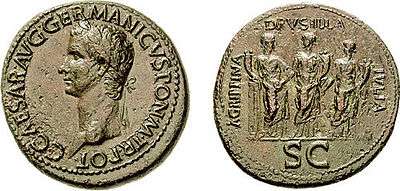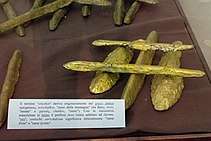Orichalcum
Orichalcum or aurichalcum /ˌɔːrɪˈkælkəm/ is a metal mentioned in several ancient writings, including the story of Atlantis in the Critias of Plato. Within the dialogue, Critias (460–403 BC) claims that orichalcum had been considered second only to gold in value and had been found and mined in many parts of Atlantis in ancient times, but that by Critias's own time orichalcum was known only by name.
| Orichalcum | |
|---|---|
 A sestertius coin from the time of Caligula | |
| Type | Metal |
Orichalcum may have been a noble metal such as platinum,[1] as it was supposed to be mined, or one type of bronze or brass or possibly some other metal alloy.[2] In 2015, metal ingots were found in an ancient shipwreck in Gela, Sicily, which were made of an alloy primarily consisting of copper, zinc and small percentages of nickel, lead, and iron.[3]
In numismatics, orichalcum is the golden-colored bronze alloy used by the Roman Empire for their sestertius and dupondius coins.[4]
Overview
The name is derived from the Greek ὀρείχαλκος, oreikhalkos (from ὄρος, oros, mountain and χαλκός, chalkos, copper), meaning literally "mountain copper".
The Romans transliterated "orichalcum" as "aurichalcum", which was thought to literally mean "gold copper". It is known from the writings of Cicero that the metal which they called orichalcum resembled gold in color but had a much lower value.[5] In Virgil's Aeneid, the breastplate of Turnus is described as "stiff with gold and white orichalc".
Orichalcum has been held to be either a gold-copper alloy, a copper-tin or copper-zinc brass, or a metal or metallic alloy no longer known.
In later years, "orichalcum" was used to describe the sulfide mineral chalcopyrite and also to describe brass. However, these usages are difficult to reconcile with the claims of Plato's Critias,[6] who states that the metal was "only a name" by his time, while brass and chalcopyrite were very important in the time of Plato, as they still are today.
Joseph Needham notes that Bishop Richard Watson, an eighteenth-century professor of chemistry, wrote of an ancient idea that there were "two sorts of brass or orichalcum". Needham also suggests that the Greeks may not have known how orichalcum was made, and that they might even have had an imitation of the original.[7]
In 2015, 39 ingots believed to be orichalcum were discovered in a sunken vessel on the coasts of Gela in Sicily which have tentatively been dated at 2,600 years old. They were analyzed with X-ray fluorescence by Dario Panetta of Technologies for Quality and turned out to be an alloy consisting of 75-80 percent copper, 15-20 percent zinc, and smaller percentages of nickel, lead, and iron.[8]
Ancient literature
Orichalcum is first mentioned in the 7th century BC by Hesiod, and in the Homeric hymn dedicated to Aphrodite, dated to the 630s.
According to the Critias of Plato, the three outer walls of the Temple to Poseidon and Cleito on Atlantis were clad respectively with brass, tin, and the third outer wall, which encompassed the whole citadel, "flashed with the red light of orichalcum". The interior walls, pillars and floors of the temple were completely covered in orichalcum, and the roof was variegated with gold, silver, and orichalcum. In the center of the temple stood a pillar of orichalcum, on which the laws of Poseidon and records of the first son princes of Poseidon were inscribed. (Crit. 116–119)
Pliny the Elder points out that orichalcum had lost currency due to the mines being exhausted. Pseudo-Aristotle in De mirabilibus auscultationibus (62) describes a type of copper that is "very shiny and white, not because there is tin mixed with it, but because some earth is combined and molten with it." This might be a reference to orichalcum obtained during the smelting of copper with the addition of "cadmia", a kind of earth formerly found on the shores of the Black Sea, which is attributed to be zinc oxide.[9]
Numismatics
In numismatics, the term "orichalcum" is used to refer to the golden-colored bronze alloy used for the sestertius and dupondius coins. It is considered more valuable than copper, of which the as coin was made.
See also
References
- Cf. Felice Vinci, The Baltic Origins of Homer's Epic Tales. The "Illiad", the "Odyssey" and the Migration of Myth, Inner Traditions, Rochester (Vermont) 2005.
- Caley, Earle Radcliffe (1964). Orichalcum and Related Ancient Alloys: Origin, Composition, and Manufacture: With Special Reference to the Coinage of the Roman Empire, Issues 151-154 Front Cover. American Numismatic Society. pp. 2, 92, 105.
- Lee, Rhodi (2015-01-10). "Divers Retrieve 'Atlantis' Metal Orichalcum from Ancient Shipwreck". Tech Times. Retrieved 3 August 2020.
- "Orichalcum". Forvum Ancient Coins. Retrieved 5 October 2015.
- Polehampton, Edward (1815). The Gallery of Nature and Art; Or, a Tour Through Creation and Science. R. Wilks for C. Cradock & W. Joy. p. 272.
Whether, if a person should offer a piece of gold to sale, thinking that he was only disposing of a piece of orichalcum, an honest man ought to inform him that it was really gold, or might fairly buy for a penny what was worth a thousand times as much
- "The Internet Classics Archive - Critias by Plato". mit.edu. Massachusetts Institute of Technology.
- Needham, Joseph (1974). Science and Civilisation in China. Chemistry and Chemical Technology; Part 2, Spagyrical Discovery and Invention: Magisteries of Gold and Immortality. 5. Cambridge University Press. pp. 227–228. ISBN 978-0521085717.
- Jessica E. Saraceni. "Unusual Metal Recovered from Ancient Greek Shipwreck". Archaeology Magazine. archaeology.org.
- Zhirov, Nicholas F. (2001). Atlantis: Atlantology: Basic Problems. The Minerva Group, Inc. p. 46. ISBN 0-89875-591-3.
External links

